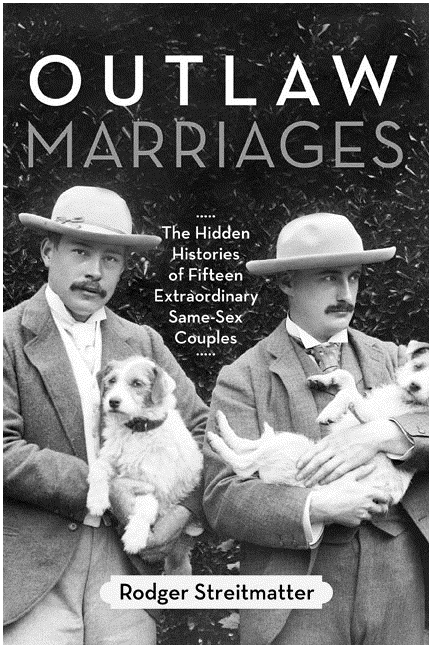The Hidden Histories of Fifteen
Extraordinary Same-Sex Couples
Rodger Streitmatter
(Beacon)

And there are a few that you (and I) are not at all familiar with: Ned Warren and John Marshall (they collected art for the Museum of Fine Arts in Boston and the New York's Met); Ismail Merchant and James Ivory (they produced films like A Room with a View and Howard's End); And J. C. Leyendecker and Charles Beach (Joe did covers for The Saturday Evening Post and invented the "Arrow Collar Man;" Charles was the model).
The fifteen brief life summaries here are of a piece. Date of birth; how they met; what they did; how one helped (or hindered) the other; how they succeeded (almost all the stories here are success stories). How they loved, how they fought, how they fell apart or lost each other or stayed faithful to each other. And who knew their secret.
For that is the big one here. Ranging from 1865 (Whitman and Doyle) to 1988 (Frances Clayton and Audre Lorde), the times were not kind to or for gay couples.
It seems that it may well have been easier for those from the very early, more innocent days, when the word "homosexual" wasn't the key word. Jane Addams, a revolutionary figure (she met with President Wilson four times to try to keep America out of WWI) was no shrinking violet; and she did nothing to hide her love for Mary Rozet Smith, even calling it, as it was, a "marriage." Walt Whitman, on the other hand, made up a family whole-cloth, and in a letter to a fan in England, he claimed to have "had six children --- two are dead."
Most of the couples here --- at least well before the end of the last century --- were evasive on the subject of their love and, according to the research provided by Streitmatter, in their final obituaries, were protected by the newspapers of the day. When Aaron Copeland passed on at ninety, the Times referred to him as "a life-long bachelor." When Greta Garbo died, "None of the obituaries or numerous tributes that appeared in the nation's major publications made any mention of Mercedes de Acosta."
And the author speculates that Jasper Johns and Rauschenberg had a major falling out over a painting that the latter had done as part of his "Inferno" series. Dante had written that men who indulged in homosexual behavior were doomed to spend the rest of eternity running on burning desert sands as punishment. Johns thought that Rauschenberg's painting in 1960 showing a Hot Foot --- his own foot outlined in red --- was just too revelatory.
Some of the facts in Outlaw Marriage should be stuck in the "how-do-you-know?" box. For instance, the statement that, while studying in Paris, Aaron Copeland "recognized his attraction to men, but he didn't become sexually involved with anyone while living abroad," is, we suspect, a little hard to prove. This is a very secretive man, alone in the city: we suspect that neither Streitmatter nor anyone else was there in his bedroom to check on his night time visitors.
Further, the book seems to downplay the intense pressure on most couples to hide their love, an automatic reaction to American society's disgust for what we now so easily call "gay" love. The author seems to have forgotten that up to a half-century ago, America's loathing was embodied in a series of horrific laws on the state level.
Same-sex love was a felony in forty-seven of the forty-eight states; arrest could subject one to jail time, loss of job, institutionalization, and, in a few cases, castration. Up to 1970, if Tenneesee Williams had been busted at a gay party in Georgetown, the liberal Washington Post --- which had praised his works so often in the pages of the newspaper --- would have posted his name in agate type in the D. C. crime section along with all others suspected of being involved in "infamous acts."